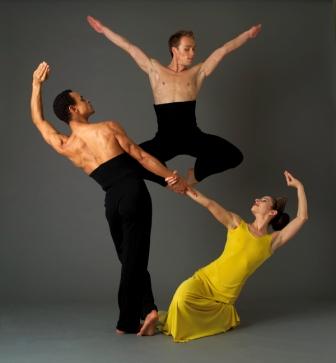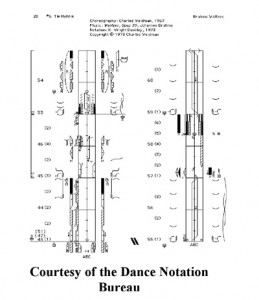
The re-staging of work establishes a genealogy in dance. Many companies reproduce historical compositions, and as new pieces are created these works enter into the collective ouevre of the field. Technology, notation and personal recollection can all help in re-staging dances, but no one means of archiving can capture the totality of a choreography. Past analysis has tended to evaluate the use of archival methods separately. Only a collaborative archival network combining technology, notation and personal knowledge can ensure the future of repertory.
Technology has provided indispensable archival opportunities in the field of dance. In particular, video has transformed the creative, marketing, and archival process. Live performance is fleeting and impermanent by nature, and the power to film these transient moments creates an un-paralleled resource. With good reason, video is usually the first step in re-creating an earlier work, but it is imperative to acknowledge its limitations. First, traditional video obtains only a two-dimensional image. This provides a good first glimpse of the movement, but not enough detail to re-stage with any precision or rigor. It is impossible to remain true to the nuances and intricacies of complex movement styles – such as the choreography of Twyla Tharp, Bill T. Jones or Trisha Brown – with a two-dimensional view. Second, when looking at video, there is a limited perspective. You are at the mercy of who took the video and who was dancing the work when it was taped. Even professional videographers can miss things, and what if they miss something that is a crucial part of the piece? Dance is changeable. No one piece is ever performed the same way twice. There are always slight, or sometimes not so slight, adjustments for different spaces and different dancers. The expectation is that video captures the most accurate depiction of the work, but this is more a hope than a certainty.
Three dimensional image capture is an exciting technological alternative to conventional video because it can convey a more complete representation of movement. This relatively new technology requires multiple cameras positioned at different angles and heights so as to record a three dimensional figure. The archival applications for this technology are incredibly exciting, but sadly, untapped. This type of filming can be very expensive and thus, not an option for many dance companies. In point of fact, a minority of companies dedicate resources toward preparation of archival material. In addition, 3-D technology has become stalled and somewhat stuck in the performance arena. Choreographers today seem to have an obsession with how ‘mixed media’ and ‘corporeal presence’ (the new go-to buzz phrases in dance) can transform a work within active performance. For all of these reasons, 3-D imagery has not penetrated into the field of archiving.
 The most under utilized archival method is dance notation. Labanotation and Benesh Movement Notation are the two primary systems that can provide a written record of choreography. Both employ a specific system of markings that indicate which body part is moving, the impetus for the motion, the direction, speed and duration of the choreography. Both Laban and Benesh are like hieroglyphics: they are an entire language, very detailed, extensive, and providing a directional map to unlock the minutiae of movement. In theory, dance notation is a great idea, but because the number of people fluent in dance notation is small, and the time/expense of notating a dance significant, written notation exists for a fraction of the important ouvre of modern dance work, and is accessible to an even smaller number of practitioners.
The most under utilized archival method is dance notation. Labanotation and Benesh Movement Notation are the two primary systems that can provide a written record of choreography. Both employ a specific system of markings that indicate which body part is moving, the impetus for the motion, the direction, speed and duration of the choreography. Both Laban and Benesh are like hieroglyphics: they are an entire language, very detailed, extensive, and providing a directional map to unlock the minutiae of movement. In theory, dance notation is a great idea, but because the number of people fluent in dance notation is small, and the time/expense of notating a dance significant, written notation exists for a fraction of the important ouvre of modern dance work, and is accessible to an even smaller number of practitioners.
The importance of personal coaching and personal experience cannot be overlooked when staging previous works. Having individuals with experience of the staged work (whether the choreographer, one of the original dancers, or a dance historian) present during re-creation significantly informs the reconstruction process. These individuals may not be able to ensure an exact replication of the steps, but many essences and ‘isms’ are beyond the capabilities of technology and notation. Admittedly, as with technology and notation, individual memory/personal coaching does have its limitations. One challenge is that this type of knowledge cannot be institutionalized, and so is uncertain from generation to generation.
Every archival process can make a positive contribution, yet on their own, each system is insufficient. To preserve our important cultural heritage, what is needed is the application of a thoughtful, reliable, and collaborative archival practice integrating technology, notation and personal resources to the fullest extent possible. Dance companies generally lack the funds to utilize all available archival systems when re-staging choreography. And, the limited funds that exist to create or stage work tend not to include the funds necessary for integration of archival concerns (money to access the newest technology, arrange for a notation, etc.) Archival policies for the field need to be developed, both to ensure preservation and performance of important works, and to encourage the funding mechanisms necessary to institutionalize appropriate archival/reconstruction policies.
Heather Desaulniers is a freelance dance writer and critic, based in Washington, D.C. She contributes regularly to criticaldance.com, and is currently pursuing historical research on choreographers Sophie Maslow and Pola Nirenska. She is also an associate editor of Bourgeon.
[…] Claudia La Rocco covers Ontheboards.tv & Bourgeon talk Archiving. […]
I enjoyed the article about the process of preserving dance. The article states that notation is underutilized. Athough I agree with the statment, it may not be clear from what is written that thousands of dance notation scores acturally exist and are archived. These include such masterpieces as Martha Graham’s “Lamentation” and “Appalachian Spring,” Doris Humphrey’s “Day on Earth” and “The Shakers,” Charles Weidman’s “Atavisms — Lynchtown” and “Flickers”, Mary Wigman’s “Hexentanz” (“Witch Dance”) and “Themes from Totentanz” (Dance of Death), Paul Taylor’s “Aureole” and “Esplanade,” Jose Limon’s “The Moor’s Pavane” and “Missa Brevis,” Merce Cunningham’s “Totem Ancestor,” Erick Hawkins’s “Death is the Hunter,” Anna Sokolow’s “Rooms” and “Dreams,” David Parson’s “Caught” and “The Envelope,” Alvin Ailey’s “Revelations,” Hwai Min Lin’s “Legacy,” Lester Horton’s “The Beloved,” Kurt Jooss’s “The Green Table,” Robert Battle’s “Primate” Helen Tamiris’s “Negro Spirituals,” Hanya Holm’s “Jocose,” and works of Alwin Nikolai, Murray Louis, Katherine Dunham, Moses Pendelton, Allison Chase, Bill T. Jones, Mark Morris, Sophie Maslow, Loie Fuller, Ted Shawn, Ruth St. Dennis, along with so many more. This month alone, 40 performances are on stage because of the Dance Notation Bureau’s (DNB’s) work. 461 different dance companies/schools/individuals have contracted with the DNB for stagings over the last couple decades.
There may also be confusion from the article about how dances written in notation are not accessible. One should separatge the ability to write notation from the ability to read notation. While it takes extensive training to skillfully analyze movement and write it in a symbolic language, trained dancers can be taught the basics to read non-complex dances in a familiar technique within hours. A 3-hour class was taught to New York Theater Ballet dancers in December, and they were reading a score. In a 2-week period of training, the “Page-to-stage” classes result in capable Labanotation readers. If you’ve seen children using the video/arcade game “Dance, Dance Revolution,” you’ve seen them reading dance notation, learning the foot patterns as quickly as the music demands. Each step registers on a mat, and missteps end the turn. The basics are intuitive and very easy to learn. There are millions of users.
Accessiblity doesn’t really depend on all dancers reading a score. Most often, when a dance company or school contracts for a score, it hires or has on staff a stager who translates Labanotation on the page onto the body, someone who sets the dance in the same way any other stager comes in and stages a dance. The only difference may be that the stager uses the score, rather than memory, to set the steps. In many of these cases the dancers are unaware that a score has ever been used.
In terms of archiving work, paper can last millenia (acid-free paper, properly stored). The recording media mentioned in the article don’t. The DNB keeps recordings and has had many formats: film (8 mm, 16 mm), videotape (1/2 inch and 1/4 inch reel-to-reel), Beta, VHS, Umatic, and DVDs. The DVDs are the least stable. The cost of conversion can be very high, especially if repairs are needed because of degradation of the medium (stretching, burning, breakage, scratches). This should be considered part of the cost.
More information about Labanotation, scores, training available, and the process is available on the Dance Notation Bureau’s web site: dancenotation.org.
Thank you for this detailed and informative comment on notation. I don’t dispute that current notation systems exist to record and re-stage dance works. There are notation scores available (as you listed), notators who competently transcribe material, and stagers who have an advanced ability to read and interpret the scores. Absolutely.
What I am suggesting is that we should not be satisfied with the status quo. Growth, change and development are crucial to dance and choreography, and I believe that all forms of archiving need to be open to the same processes of innovation and improvement.
A popular video game and three-hour seminars are good starts in learning dance notation: an introduction; a chance to experience the basics. There should be more of these opportunities! At the same time, you note that not all dancers have to read notation for it to be accessible. That may be true but why wouldn’t we want more dancers to be able to read it and read it accurately? These are the artists who may be onstage now, but will likely be choreographing and creating offstage in the future. We should want them to have as much knowledge, skill and education as is possible, including an in-depth understanding of notation.
We can do a better job of archiving by improving and integrating every available system. Clearly, notation has a long tradition and widespread usage. An even vaster scope through an increased access to notation training can only help this important archival practice not hinder it.
[…] movement. What will be will be. Gallery. Language. English. BHS. Categories. Drawings. Photos …Archiving Dance: The Necessity of Collaboration | BourgeonPreserving our cultural heritage requires a collaborative archival practice integrating technology, […]
[…] Archiving Dance: The Necessity of Collaboration by Heather Desaulniers […]
[…] video art? Online art? Performance Art? Dance? One of our Bourgeon editors recently published an article about this issue. I’m guessing that the people the Hirshhorn bring in will spark informed […]
[…] who worked for the New York City Ballet, discussed historical and recent attempts to archive live dance performance, and her discussion included various approaches to dance […]
[…] who worked for the New York City Ballet, discussed historical and recent attempts to archive live dance performance, and her discussion included various approaches to dance […]
[…] who worked for the New York City Ballet, discussed historical and recent attempts to archive live dance performance, and her discussion included various approaches to dance […]
[…] who worked for the New York City Ballet, discussed historical and recent attempts to archive live dance performance, and her discussion included various approaches to dance […]